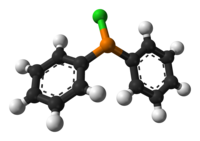Chlorodiphenylphosphine
 |
|
 |
|
| Names | |
|---|---|
|
Preferred IUPAC name
Diphenylphosphinous chloride
|
|
| Other names
chlorodiphenylphosphine
p-chlorodiphenylphosphine diphenyl phosphine chloride diphenylchlorophosphine |
|
| Identifiers | |
|
3D model (Jmol)
|
|
| ChemSpider | |
| ECHA InfoCard | 100.012.813 |
| UNII | |
|
|
|
|
| Properties | |
| C12H10ClP | |
| Molar mass | 220.63776 g mol−1 |
| Appearance | clear to light yellow liquid |
| Density | 1.229 g cm−3 |
| Boiling point | 320 ˚C |
| Reacts | |
|
Except where otherwise noted, data are given for materials in their standard state (at 25 °C [77 °F], 100 kPa).
|
|
|
|
|
| Infobox references | |
Chlorodiphenylphosphine is an organophosphorus compound with the formula (C6H5)2PCl, abbreviated Ph2PCl. It is a colourless oily liquid with a pungent odor that is often described as being garlic-like and detectable even in the ppb range. It is useful reagent for introducing the Ph2P group into molecules, which includes many ligands. Like other halophosphines, Ph2PCl is reactive with many nucleophiles such as water and easily oxidized even by air.
Chlorodiphenylphosphine is produced on a commercial scale from benzene and phosphorus trichloride (PCl3). Benzene reacts with phosphorus trichloride at extreme temperatures around 600 °C to give dichlorophenylphosphine (PhPCl2). Redistribution of PhPCl2 in the gas phase at high temperatures results in chlorodiphenylphosphine.
Alternatively such compounds are prepared by redistribution reactions starting with triphenylphosphine and phosphorus trichloride. Synthesis of Ph2PCl by the direct reaction of phenylmagnesium bromide and phosphorus trichloride is not practiced. On the other hand, PCl3 can be usefully converted to its monoamide, which in turn undergoes alkylation or arylation. Subsequent removal of the amide gives :
Unlike the synthesis of chlorodiisopropylphosphine, reaction of two equivalents of the phenyl Grignard reagents with PCl3 does not efficiently afford the monochloride.
Chlorodiphenylphosphine hydrolyzes to give diphenylphosphine oxide. With amines, it forms the amides Ph2PNR2.
...
Wikipedia
